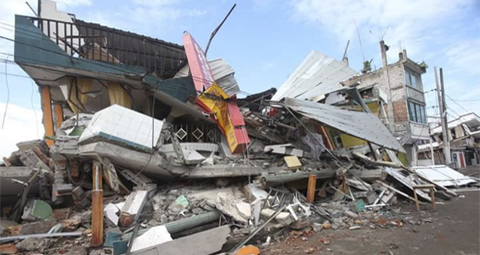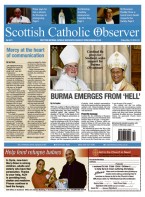April 29 | ![]() 0 COMMENTS
0 COMMENTS ![]() print
print

From Ecuador’s epicentre April 17
Scottish priest FR COLIN MACINNES, a missionary living and working in Guayaquil, Ecuador, gives a first hand account of the recent tragic earthquake in the Latin American country
The sanctuary chair I was sitting on started moving, then rocking and after a few seconds, which seemed like an eternity, it seemed that the chair wanted to start dancing. It was a strange sensation. I immediately realised that this was not one more of the occasional tremors we get in the country. The situation was far more serious. When the movement subsided I remained seated. I thought that there was only a light zinc roof above me and it would not do much damage even if it started to fall whereas there was a semblance of a small bell tower above the main door and I was almost sure that would be falling any minute. Therefore I remained seated. In these circumstances thoughts pass rapidly through the mind.
There were other people in the church as we had just finished a ‘Holy Hour’ on April 17 which we celebrate daily from 6pm in order to start Mass at 7pm. All stood up, a few moved towards the door, but most stood petrified for a short while and then started hugging each other for comfort. As they were regaining their sense fear spread across the church like a dark cloud. I stood up and called them all to prayer. In a quiet deliberate way we prayed the Our Father. There was a miraculous transformation. People relaxed. There was a sensation that the danger had passed and all was well again. We celebrated Mass confidently and joyfully, prayed for people in danger and that calm and harmony might return.
It was after Mass that the seriousness of the situation began to dawn on us. A young man with a cellular phone approached me and showed me a picture of one of the flyovers in the centre of Guayaquil which had fallen and had smashed through a passing car. There was no possibility the people inside could be alive. I went upstairs to see the news coming through on television. The mass media had been caught by surprise; most of the staff had finished their day’s work and it was some time later that we learned that the epicentre of the earthquake was on a small semi-island just off the coast called Muisne.
When Canon McQueen and Fr Callum McLellan, of happy memory, had visited me in Ecuador some twenty five years ago we visited the island of Muisne. At that time there was no road to Muisne and we had to travel a mile or so by canoe in order to get there. Since then a fine road has been constructed and what was an earthly extension of paradise has become a quiet attractive tourist resort. I remember swimming along the shore. The water was crystal clear; the sun rays penetrated the water and lit up coral reefs below where myriad shoals of fish of every colour, shape and size pranced about. I promised myself that I would be back and spend a number of days there just to try to absorb the beauty and mystery of the island. That was more than 25 years ago and this promise is filed with other promises I have made on visiting a number of other places in Ecuador of unrivalled beauty and fascination.
They tell me that, as a result of the earthquake, the island has been scorched as if a tsunami had passed right over it. Few if any buildings remain standing. The newly constructed highway leading to the island is unpassable and so access will once again be by boat or canoe. It is not known how many people have survived the earthquake, the state of potable water, basic sanitation and the food provision for survivors. It makes me sad just to think of how an idyllic spot has been so mercilessly struck off the face of the earth.
The earthquake was of a force of 7.8 on the Richter scale and is reckoned to have been twenty times stronger than the recent earthquake in Japan. A year after coming to Ecuador there was an earthquake that did very considerable damage to infrastructure but not claim many lives. At that time it was mainly on the Andean Sierras, the Highlands of Ecuador. The city of Quito, the nation’s capital, was badly affected. Towers fell off churches; five of the ancient Sanctuaries (declared to be the patrimony of humanity by UNESCO) were badly damaged and the roads towards eastern Ecuador were partially destroyed so that one half of the country was isolated from the other half. I remember back in Scotland reading an article in the Sunday Observer (I think that was the name of the newspaper) and it described the scene of devastation throughout the country. The title of the article was “Earthquake the World Forgot about”. It will be sad if history is repeated and considerable aid does not arrive from outside. The need is great.
The economic state of the country is critical. Oil prices, which were the main source of income of the country, have fallen drastically and now oil is extracted from the ground at a loss; the price of the dollar has risen sharply and as Ecuador is a dollarised currency it finds that there is little demand for its goods as neighbouring countries that have similar products for export have devalued their currency and are more competitive for the export trade. The country is in recession, is going through an economic crisis and Government is finding it difficult to pay its workers, its contractors, internal and external debts. The coming years look bleak. The country has just suffered the effects of what we call the Niño and many towns and villages along the coast were flooded during the past two months. Homes, shops and businesses, normally located at street level, were inundated before residents could do much about salvaging their belongings; crops were lost and country roads were washed away. Recuperation plans were just being put in motion when the earthquake struck.
The state of the country is that of a wrecked ship being tossed about on very heavy seas. At the same time though material damage is very considerable the loss of lives is even more saddening and the sorrow is more enduring. At the moment the death role is working its way towards the 600 mark. Material things can be replaced but the loss of a member of the family, of a dear one, is irreplaceable. I think that there is a consciousness in the county of this fact and we hear of all forms of solidarity and help coming from every quarter as people try to help bear the burden of loss of others. Catholic parishes throughout the country are giving a great example to all and our own parish of St Theresa of the Child Jesus is playing its part. If town or city councils, local authorities and other voluntary bodies in Scotland want to help I would be pleased to channel their aid if they find it difficult to do it in a more formal way. In circumstances such as ours making the aid arrive at the right people is the challenge. Finally, I would ask you all to pray for the poor people who are suffering so much that God may give them fortitude to face the future with hope and joyful hearts.
These are dark days for Ecuador but they are days where faith uplifts the mind and strengthens human resolve. It was a joyful moment for the congregation of St Theresa’s and a proud moment for me when my niece, Allan MacInnes (above), lead the offertory procession gracefully playing the Scottish bagpipes. The poor people are also grateful to the cases of clothes my Mary, my sister-in-law and her two daughters brought with them. The clothes are now being distributed to the victims of the earthquake. Bornish, Uist and the Isles have always been generous and I am sure that they are pleased to make their contribution in this moment of need of a nation.











